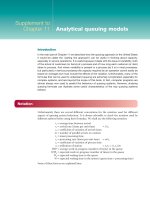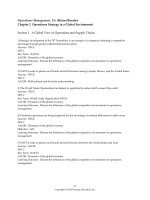Operations management heizer 6e ch09
Bạn đang xem bản rút gọn của tài liệu. Xem và tải ngay bản đầy đủ của tài liệu tại đây (1.66 MB, 75 trang )
Operations
Management
Chapter 9 –
Layout Strategy
PowerPoint presentation to accompany
Heizer/Render
Principles of Operations Management, 6e
Operations Management, 8e
© 2006
Prentice
Hall, Inc. Hall, Inc.
©
2006
Prentice
9–1
Outline
Global Company Profile:
McDonald’s
The Strategic Importance
Of Layout Decisions
Types of Layout
Office Layout
© 2006 Prentice Hall, Inc.
9–2
Outline – Continued
Retail Layout
Servicescapes
Warehousing and Storage Layouts
Cross-Docking
Random Docking
Customizing
Fixed-Position Layout
© 2006 Prentice Hall, Inc.
9–3
Outline – Continued
Process-Oriented Layout
Computer Software for ProcessOriented Layouts
Work Cells
Requirements of Work Cells
Staffing and Balancing Work Cells
The Focused Work Center and the
Focused Factory
© 2006 Prentice Hall, Inc.
9–4
Outline – Continued
Repetitive and Product-Oriented
Layout
Assembly-Line Balancing
© 2006 Prentice Hall, Inc.
9–5
Learning Objectives
When you complete this chapter, you
should be able to:
Identify or Define:
Fixed-position layout
Process-oriented layout
Work cells
Focused work center
Office layout
© 2006 Prentice Hall, Inc.
9–6
Learning Objectives
When you complete this chapter, you
should be able to:
Identify or Define:
Retail layout
Warehouse layout
Product-oriented layout
Assembly-line
© 2006 Prentice Hall, Inc.
9–7
Learning Objectives
When you complete this chapter, you
should be able to:
Describe or Explain:
How to achieve a good layout for the
process facility
How to balance production flow in a
repetitive or product-oriented facility
© 2006 Prentice Hall, Inc.
9–8
Innovations at McDonald’s
Indoor seating (1950s)
Drive-through window (1970s)
Adding breakfast to the menu
(1980s)
Adding play areas (1990s)
Three out of the four are
layout decisions!
© 2006 Prentice Hall, Inc.
9–9
McDonald’s New Kitchen
Layout
Fifth major innovation
Sandwiches assembled in order
Elimination of some steps, shortening of
others
No food prepared ahead except patty
New bun toasting machine and new bun
formulation
Repositioning condiment containers
Savings of $100,000,000 per year in food
costs
© 2006 Prentice Hall, Inc.
9 – 10
McDonald’s
New Kitchen
Layout
© 2006 Prentice Hall, Inc.
9 – 11
Strategic Importance of
Layout Decisions
The objective of layout strategy
is to develop an economic layout
that will meet the firm’s
competitive requirements
© 2006 Prentice Hall, Inc.
9 – 12
Layout Design
Considerations
Higher utilization of space, equipment,
and people
Improved flow of information, materials,
or people
Improved employee morale and safer
working conditions
Improved customer/client interaction
Flexibility
© 2006 Prentice Hall, Inc.
9 – 13
Types of Layout
1. Office layout
2. Retail layout
3. Warehouse layout
4. Fixed-position layout
5. Process-oriented layout
6. Work cell layout
7. Product-oriented layout
© 2006 Prentice Hall, Inc.
9 – 14
Types of Layout
1. Office layout - positions workers,
their equipment, and spaces/offices
to provide for movement of
information
2. Retail layout - allocates shelf space
and responds to customer behavior
3. Warehouse layout - addresses
trade-offs between space and
material handling
© 2006 Prentice Hall, Inc.
9 – 15
Types of Layout
4. Fixed-position layout - addresses
the layout requirements of large,
bulky projects such as ships and
buildings
5. Process-oriented layout - deals with
low-volume, high-variety production
(also called job shop or intermittent
production)
© 2006 Prentice Hall, Inc.
9 – 16
Types of Layout
6. Work cell layout - a special
arrangement of machinery and
equipment to focus on production of
a single product or group of related
products
7. Product-oriented layout - seeks the
best personnel and machine
utilizations in repetitive or
continuous production
© 2006 Prentice Hall, Inc.
9 – 17
Good Layouts Consider
1. Material handling equipment
2. Capacity and space requirements
3. Environment and aesthetics
4. Flows of information
5. Cost of moving between various
work areas
© 2006 Prentice Hall, Inc.
9 – 18
Layout Strategies
Office
Retail
Warehouse
(storage)
Examples
Allstate Insurance
Microsoft Corp.
Kroger’s
Supermarket
Federal-Mogul’s
warehouse
Walgreens
The Gap’s
distribution center
Bloomingdale’s
Locate workers
requiring frequent
contact close to
one another
Problems/Issues
Expose customer
to high-margin
items
Balance low-cost
storage with lowcost material
handling
Table 9.1
© 2006 Prentice Hall, Inc.
9 – 19
Layout Strategies
Project
(fixed position)
Examples
Ingall Ship Building
Corp.
Trump Plaza
Job Shop
(process oriented)
Arnold Palmer Hospital
Hard Rock Cafes
Pittsburgh Airport
Problems/Issues
Move material to the
limited storage area
around the site
Manage varied material
flow for each product
Table 9.1
© 2006 Prentice Hall, Inc.
9 – 20
Layout Strategies
Work Cells
(product families)
Repetitive/ Continuous
(product oriented)
Examples
Hallmark Cards
Wheeled Coach
Standard Aero
Problems/Issues
Identify product family,
build teams, cross train
team members
Sony’s TV assembly
line
Dodge minivans
Equalize the task time
at each workstation
Table 9.1
© 2006 Prentice Hall, Inc.
9 – 21
Office Layout
Grouping of workers, their
equipment, and spaces to provide
comfort, safety, and movement of
information
Movement of information is main
distinction
Typically in state of flux due to
frequent technological changes
© 2006 Prentice Hall, Inc.
9 – 22
Relationship Chart
Value
1
President
Chief Technology Officer
Engineer’s area
Secretary
Office entrance
Central files
Equipment cabinet
Photocopy equipment
Storage room
© 2006 Prentice Hall, Inc.
A
Absolutely
necessary
E
Especially
important
I
Important
O
Ordinary OK
U
Unimportant
X
Not desirable
2
3
O
4
U
A
5
A
I
O
I
I
E
X
U
E
9
O
O
E
U
O
I
X
O
U
8
U
A
U
O
U
O
I
A
7
I
I
I
A
6
Closeness
A
E
E
Figure 9.1
9 – 23
Supermarket Retail Layout
Objective is to maximize
profitability per square foot of
floor space
Sales and profitability vary
directly with customer exposure
© 2006 Prentice Hall, Inc.
9 – 24
Five Helpful Ideas for
Supermarket Layout
1. Locate high-draw items around the
periphery of the store
2. Use prominent locations for high-impulse
and high-margin items
3. Distribute power items to both sides of
an aisle and disperse them to increase
viewing of other items
4. Use end-aisle locations
5. Convey mission of store through careful
positioning of lead-off department
© 2006 Prentice Hall, Inc.
9 – 25









